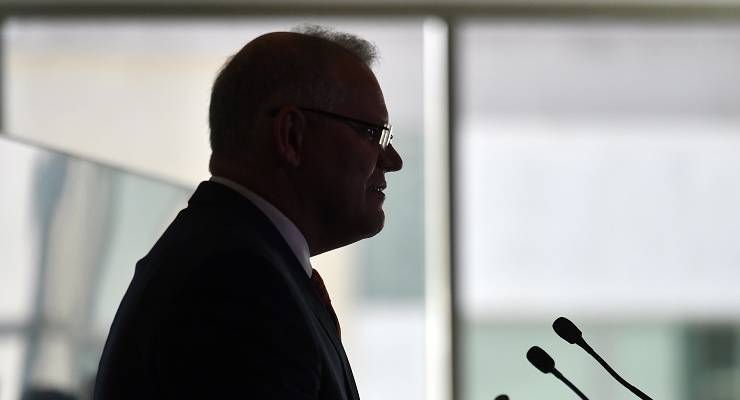
Scott Morrison was on his way to a certain reelection, and then a funny thing happened: journalists started to take him seriously.
Suddenly, more than a few seem to be stumbling out of his press conferences with the head-shaking muttering of an old couplet:
Yesterday, upon the stair,
I met a man who wasn’t there!
No surprise. Morrison has built his career out of not being there. He’s the accidental PM: sliding through the middle of his party’s moderate/hard right wars (and trading on its reluctance to give a woman a go), then confronting an opposition that was a bit too keen to talk about itself.
He’s turned “I don’t hold a hose, mate” into a governing philosophy.
Even COVID-19 worked out for him. With the bar of community expectations set so low after the summer’s bushfires, he was able to lever the hard work of the state premiers to get him up and over into 2021.
Previous prime ministers sought to dominate the news cycle. But Morrison keeps his head down. He prefers to communicate through heavily gendered images on TV and social media that remind everyone that he’s just a bloke doing his best.
We saw it again on Saturday night. The PM put on his “aw shucks” face and shuffled into the Parramatta Eels’ change room for a celebratory beer with the boys, broadcast live to his preferred micro-audience on Fox Sports.
It was a real-time reinforcement of Katharine Murphy’s astute take in Guardian Australia earlier that day: “This prime minister speaks almost exclusively to one cohort of voters: men at risk of voting Labor.”
It’s hard to believe, but the government is paralysed by the risk of losing this cohort (and a slab of the backbench) by being considered too supportive of women.
It seems another age, but just two months ago, the press gallery orthodoxy was that the country’s COVID success had entrenched Morrison as PM. Everyone expected him to start spending his political capital on action.
This turned out to be a dangerous situation for the PM. It raised journalists’ expectations. It encouraged a deeper reading of his words — from his Hawke-likened industry round tables, his “preference” for net zero emissions by 2050, or his “openness” to quotas for women. It forced a more critical look at the government’s announce-ables from bushfire relief to vaccine rollout.
Morrison doesn’t just hang around footballers. He’s brought football strategy into politics: the belief that success comes less from what you do, and more from the mistakes you press your opponents to make.
Morrison has concluded that doing nothing — not being there — is smart politics. The trouble is, there are a few hundred journalists who expect the government to do things to report on.
If Morrison doesn’t hold the hose of stories (and the opposition won’t fill the gap with big policy promises of its own), journalists will look elsewhere. And, by looking elsewhere, they have exposed the vacuum at the heart of the government.
That looking has coincided with the rise in Me Too stories. Behaviour that once went unreported is now being dug out, contextualised and broadcast out on the evening news.
The conservatives splutter in surprise, but it’s the inevitable turn in the culture wars they’ve been fighting since the 1960s. Politics has been used to delay, frustrate, obfuscate — to wedge the left with zero-sum claims on equality. As Morrison said, for example, on International Women’s Day just two years ago: the rise of women could not be allowed to come at the expense of men.
Now, as The Australian‘s Paul Kelly noted last week (perhaps mournfully): culture has overrun politics. That demands a do-something reset. Yet Morrison is damned either way. In the modern Liberal Party, policy resets cost leaders their jobs.
The consistent line out of Canberra is “no one’s counting numbers”. But that’s code for: Morrison is on notice for now. It suggests it won’t be long until his colleagues start muttering the second couplet about the man on the stair:
He wasn’t there again today,
Oh how I wish he’d go away!








Why was this bloke sacked from The Australian Tourist Commission by Liberal minister Bailey and why was he sacked from the New Zealand Tourist Commission?
Because he f**ked them over with financial fraud which has been swept under a carpet by the Liberal party and the MSM.
how does Scumo keep getting credit for “his handling of the pandemic”? *
the states did the bulk of the heavy-lifting, forcing Scumo to follow their lead
and when Scumo did act, it was to throw influence and cash at his party mates …
* Newscorp
Australian politicians must have the highest average age anywhere in the world.
Pale, Stale and Male describes them perfectly.
In fairness – compared to the US where congress is pretty much an aged care facility, APH looks like a backpackers hostel.
I believe their pay scale is amongst the best as well.
Scotty can’t implement policies because his party is so factionally divided that the only “policy” they can agree on is to keep Labor out. Take that away and they have nothing.
Yep, and that’s why everything they do is a wedge; in the case of stopping the boats and incarcerating asylum seekers off-shore it’s a permanent wedge.
“If Morrison doesn’t hold the hose of stories (and the opposition won’t fill the gap with big policy promises of its own), journalists will look elsewhere. And, by looking elsewhere, they have exposed the vacuum at the heart of the government.”
If I was the Opposition I would keep quiet too.
When the clown on stage is making it clear, over and over and over again’ that getting him back for another gig is not what the audience wants; and when the audience is seething about the gauche performance they are witnessing, you would want to let that sink in.
When the audience and commentators ‘lift their heads’, they will be ready to hear what the alternative government has to say.
If I was that Government-in-waiting I would have the script ‘ready to roll’ whenever it is clear the ‘judging panel’ is not only paying attention, but willing them to succeed.
You give me hope, Ken.